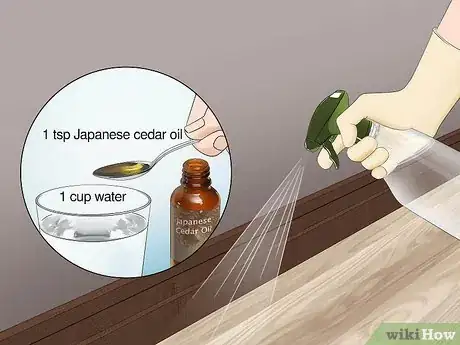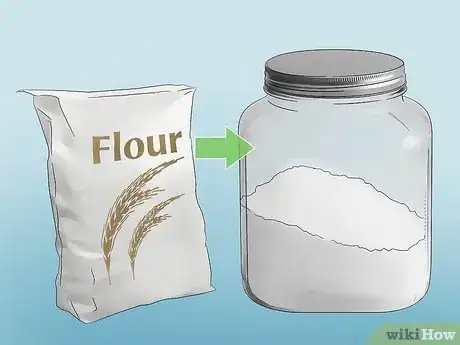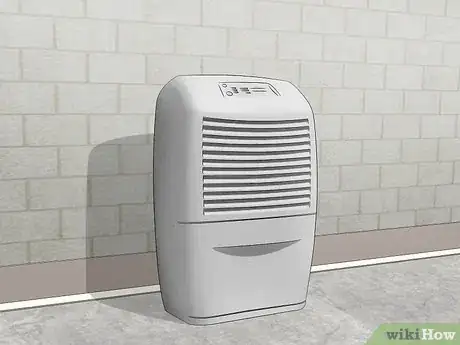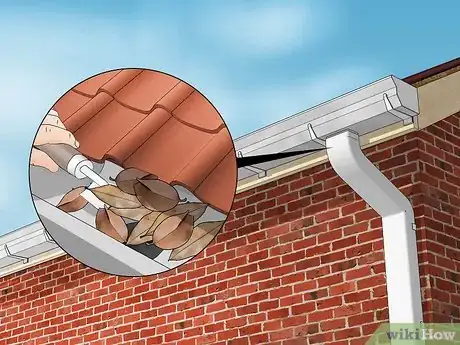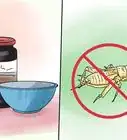This article was co-authored by Elmer Bensinger and by wikiHow staff writer, Amy Bobinger. Elmer Bensinger is a Pest Control Specialist with Eden Advanced Pest Technologies in Spokane, Washington. With over 20 years of experience, Elmer specializes in integrated pest management and products such as insecticides and rodenticides. He studied business at South Puget Sound Community College.
There are 14 references cited in this article, which can be found at the bottom of the page.
This article has been viewed 16,339 times.
Silverfish might not be particularly dangerous to people, but they sure are creepy-looking. That's a good enough reason to want them gone, but they can also trigger allergies and cause damage to things like books, photographs, and clothing. Luckily, you can usually keep them out by making a few tweaks to your environment!
Steps
Repel silverfish with Japanese cedar oil.
-
It's been proven that this oil will repel and even kill silverfish.[1] X Research source While there's no standardized method for applying the oil, some people have had success diluting 1 tsp (4.9 ml) of the oil in 1 cup (240 ml) of water.[2] X Research source Pour this into a spray bottle, then spritz areas where silverfish might be likely to congregate, like along the walls in a damp basement or the baseboards near your bookshelves.
- You can also buy commercial silverfish repellants made with Japanese cedar oil.
Vacuum your floors and furniture frequently.
-
This will remove any particles that could be silverfish food. Silverfish can feed on crumbs, dust, and even dead insects around your home—yuck! Luckily, it's easy to keep these out of your environment with regular vacuuming.[3] X Research source
- As a bonus, if there are any silverfish running around, you'll probably suck them in the vacuum, too.[4] X Trustworthy Source EDIS Electronic database of the University of Florida Institute of Food and Agricultural Sciences's peer-reviewed articles Go to source
Get rid of any old boxes, newspapers, or magazines.
-
Paper products provide both food and shelter for silverfish. It's easy to forget about that stack of boxes you meant to put out for recycling or those magazines you never got around to reading. However, silverfish love to eat paper, especially if it's been treated with glue or it has a glossy surface.[5] X Research source If there's anything like that around your home, it's best to toss it out if you want to discourage silverfish.[6] X Trustworthy Source EDIS Electronic database of the University of Florida Institute of Food and Agricultural Sciences's peer-reviewed articles Go to source
- Similarly, purge your wardrobe regularly so you don't have clothes piled up in bins or bags—silverfish will feed on certain types of fabrics.
Store paper or fabric items in sealed containers.
-
Air-tight plastic bins will keep the silverfish out. If silverfish get into your home, they might start nibbling on any books, magazines, photographs, or even clothes that you have lying around. To help prevent that, place these items in containers with tight-fitting lids.[7] X Research source
- Sort through these containers periodically to make sure there aren't any silverfish hiding in them.
Seal up your food in airtight containers, as well.
-
Be especially sure to keep your dry goods sealed tightly. Silverfish are just one of the insects that could be attracted to your food, so this is a good practice no matter what. In particular, silverfish like dry food that's rich in carbs, like pasta, flour, and cereals.[8] X Trustworthy Source Penn State Extension Educational organization dedicated to delivering science-based information to people, businesses, and communities Go to source
- Be sure to seal up your pet food and treats, too!
Run an air conditioner or fan to lower the humidity.
-
Silverfish thrive in areas with 75-95% humidity.[9] X Research source One of the simplest ways to make your house less comfortable for them is to just keep the air moving with an AC or fan. This is especially helpful in areas that tend to be damp, like your basement or bathroom, or in places where you store books or other items silverfish like to eat.[10] X Research source
- If your bathroom doesn't have a vent fan, consider having one installed—it can make a big difference in the humidity.
Use a dehumidifier in damp rooms.
-
A dehumidifier pulls moisture out of the air. If there's a spot in your home that just always seems damp, like your bathroom, utility room, or basement, it's pretty likely to attract silverfish. By drying out the area with a dehumidifier, you might discourage insects like silverfish, as well as problems like mold and mildew.[11] X Trustworthy Source Penn State Extension Educational organization dedicated to delivering science-based information to people, businesses, and communities Go to source
- A dehumidifier can also be helpful in closed spaces, like closets or storage rooms, where silverfish may be more likely to stay hidden for a while.[12] X Research source
Fix any plumbing leaks.
-
Leaks create moisture, which will attract silverfish. If you notice a leaky pipe or a dripping faucet, repair it right away. It's probably easier than you think to do it yourself, but you can always call a plumber if you need to.[13] X Research source
- If you ignore leaky plumbing, the added moisture in and around your home could create the perfect habitat for silverfish.
- If your water meter is running even when you're not using any water, you probably have a leak somewhere.[14] X Trustworthy Source United States Environmental Protection Agency Independent U.S. government agency responsible for promoting safe environmental practices Go to source
Clear out your gutters and downspouts regularly.
-
Leaves, dirt, and other debris can build up in your gutters over time. When that happens, rain can collect inside of them, and it could start to seep into your home. That's going to create a whole lot of problems in the long run—and silverfish will probably be one of them.[15] X Trustworthy Source Penn State Extension Educational organization dedicated to delivering science-based information to people, businesses, and communities Go to source
- Clean your gutters at least twice a year—or more, if you have a lot of trees that hang over your roof.[16] X Research source
Seal your home tightly.
-
Silverfish can flatten out their bodies, so they're able to fit in the tiniest spaces. Walk around the outside of your home with a caulk gun and seal up any gaps or cracks that you see. That way, they won't be able to get into your home in the first place.[17] X Trustworthy Source Penn State Extension Educational organization dedicated to delivering science-based information to people, businesses, and communities Go to source
- A fresh coat of paint can help seal out silverfish, as well.
- Seal up the interior walls, as well. Especially check for spots like seams in the wall or gaps around your baseboards, door trim, or windows.[18] X Trustworthy Source Penn State Extension Educational organization dedicated to delivering science-based information to people, businesses, and communities Go to source
- Use expanding foam to seal holes around pipes.[19] X Research source
Deep-clean your home once or twice a year.
-
Going through everything can help you spot hiding places for silverfish. During this time, sort through your closets, cabinets, drawers, bookshelves, and storage containers. Toss out any clutter and move things around a little—if there are any silverfish hiding in the areas, they'll likely be flushed out, and you can either smash the bugs or spray them with an insecticide to kill them.[20] X Research source
- Since silverfish live in dark, cluttered areas, simply shuffling your items around every so often may help prevent an infestation.
- Be sure to clean everything thoroughly—you may be removing tiny silverfish eggs without even realizing it.
Dust dry areas with diatomaceous earth to get rid of the bugs.
-
Diatomaceous earth (DE) kills silverfish by drying them out. Sprinkle a little into your wall voids or use a duster to apply it along your baseboards. The insects don't have to eat it for it to work—just walk through it—so it's a great barrier against silverfish.[21] X Trustworthy Source EDIS Electronic database of the University of Florida Institute of Food and Agricultural Sciences's peer-reviewed articles Go to source
- The easiest way to apply DE is to pour it into a bellows duster. Just squeeze the bulb on the duster while you point the nozzle, and the duster will apply a fine layer of dust.[22] X Research source
- This works best if you've also removed any sources of moisture that are attracting the silverfish.
- Diatomaceous earth is naturally derived and non-toxic, so it's safe to use if you have kids or pets.
Use a water-based insecticide to kill silverfish on contact.
-
Spray insecticides aren't the most effective way to prevent silverfish. You're really better off making environmental changes to prevent them from getting into your home in the first place. However, a spray can be an effective way to get rid of an occasional silverfish if that's all you're dealing with. Spray it directly onto the insect or the area where it's hiding—it should kill the silverfish right away.[23] X Research source
- Be sure to carefully follow all of the label instructions, as most insecticides are toxic.
- Avoid using them around children or pets.
You Might Also Like

 The Best Ways to Get Rid of Cockroaches in Your Home
The Best Ways to Get Rid of Cockroaches in Your Home



 How to Drive Away Gnats for Good: Easy DIY Methods
How to Drive Away Gnats for Good: Easy DIY Methods
 Do You Have Animals in Your Walls? Dealing with Animals in Your Walls or Attic
Do You Have Animals in Your Walls? Dealing with Animals in Your Walls or Attic
 The Best Ways to Get Rid of Silverfish Once and for All
The Best Ways to Get Rid of Silverfish Once and for All


 How to Remove Bats from Your Home
How to Remove Bats from Your Home



References
- ↑ https://entnemdept.ufl.edu/creatures/URBAN/silverfish.HTM
- ↑ https://www.hellolidy.com/essential-oils-to-get-rid-of-silverfish/
- ↑ http://ipm.ucanr.edu/PMG/PESTNOTES/pn7475.html
- ↑ https://edis.ifas.ufl.edu/publication/IG094
- ↑ https://entnemdept.ufl.edu/creatures/URBAN/silverfish.HTM
- ↑ https://edis.ifas.ufl.edu/publication/IG094
- ↑ https://agrilife.org/aes/files/2014/06/Silverfish-and-Firebrats.pdf
- ↑ https://extension.psu.edu/bristletails-silverfish-and-firebrats
- ↑ https://lancaster.unl.edu/enviro/pest/factsheets/005-94.htm
- ↑ https://agrilife.org/aes/files/2014/06/Silverfish-and-Firebrats.pdf
- ↑ https://extension.psu.edu/bristletails-silverfish-and-firebrats
- ↑ http://ipm.ucanr.edu/PMG/PESTNOTES/pn7475.html
- ↑ http://ipm.ucanr.edu/PMG/PESTNOTES/pn7475.html
- ↑ https://www.epa.gov/watersense/fix-leak-week
- ↑ https://extension.psu.edu/bristletails-silverfish-and-firebrats
- ↑ https://www.nytimes.com/guides/realestate/home-maintenance-checklist
- ↑ https://extension.psu.edu/bristletails-silverfish-and-firebrats
- ↑ https://extension.psu.edu/bristletails-silverfish-and-firebrats
- ↑ http://ipm.ucanr.edu/PMG/PESTNOTES/pn7475.html
- ↑ http://ipm.ucanr.edu/PMG/PESTNOTES/pn7475.html
- ↑ https://edis.ifas.ufl.edu/publication/IG094
- ↑ http://ipm.ucanr.edu/PMG/PESTNOTES/pn7475.html
- ↑ http://ipm.ucanr.edu/PMG/PESTNOTES/pn7475.html
About This Article

